Guest: Rafael Paniagua, a coach at CEO Coaching International. Rafael is an experienced global leader and a longtime YPO member who is fluent in English, Spanish, and Portuguese. Prior to becoming a coach, Rafael was a CEO and President in the power, automation, and manufacturing industries, where he led ABB Brazil for seven years. He also led several global businesses as Group Vice President, managing more than 5,000 employees, 14 factories, and operating in more than 30 countries.
Episode in a Tweet: Going global could jump start your trajectory towards BIG.

Quick Background: The smaller your business is, the more vulnerable it is — to customer attrition, to supply chain disruption, to ambitious competitors, or to fallout from a global pandemic. Now that you’ve completed your digital pivot, the size of your potential customer base is limited only by the scope and quality of your sales strategy. A little extra bandwidth and an office in an emerging market stocked with triple-A talent might be all you need to grow your business into an international success.
On today’s show, Rafael Paniagua shares 4 keys to running a global business and how to make BIG happen by expanding geographically.
Keys to Running an International Business from Rafael Paniagua
1. Understand and adapt to cultural differences.
“Winning in international business is an art,” Rafael says. “If I need to select a single sentence to describe how to win, it is to be aware of cultural differences. Normally, people just assume that everyone makes the same decisions, using the same processes, the same values, the same culture, based on the same economics. And the reality is, almost everyone is different, but there are huge differences when you talk about different countries, different continents, and different environments.”
Rafael cites office communication as one cultural difference that new global CEOs might overlook. In the U.S., our meetings, emails, and conversations with direct reports tend to be succinct and to the point. In many South American cultures, Rafael says directness reads as being impolite. The CEO and team leaders need to understand those kinds of local norms to communicate clearly and effectively without turning off the international team.
“Learning the culture, that requires time,” Rafael says. “And that requires the CEO to open your mind to learning the language, learning the culture, learning the people, talking with many different people. And being honest that you don’t know everything. One of the major mistakes I’ve seen is instead of being aware of these differences, leaders just complain, or they try to change how things happen locally. And that will never happen. You need to adapt yourself. You can make some changes step-by-step, but you alone cannot change the culture and the history of a population that had been there for centuries. Spending time learning is the only way.”
2. Layer your company’s values.
While adapting your company to your new international workforce — and vice-versa — will require some give and take, some things are nonnegotiable. At the very top of the pyramid should be the key values that determine how and why your company does what it does, both at home and abroad. Below those core values, the CEO can establish values that are specific to various international markets.
“I cannot imagine having a global company that does not have a single set of values at the top,” says Rafael. “These values are accepted everywhere. Integrity is a well-accepted value. It doesn’t matter where you are, integrity needs to be present across the board wherever you are. Then you have a second layer of values that you need to adapt to the region. The way that you implement these values around the culture, around the people, how you interact with your stakeholders locally, vendors, customers, authorities, governments; that is more regional.”
3. Align your offices to achievable goals.
There’s nothing more important to the success of your business than effective planning. But when you start branching out to multiple international locations, the importance of planning multiplies as well. In order to make this expansion work, Rafael cautions against setting top-down goals in isolation. CEOs need to coordinate with the leaders in their new offices to figure out what’s achievable locally before they start thinking about adding zeroes to annual revenue.
“A successful methodology I’ve used is monthly, the global leaders sit for two to three hours, depending on the complexity of the businesses, with their main local managers in the different geographies,” says Rafael. “Two or three times per year, face-to-face, the rest virtually. Going through targets, what you have done during the past month, what has been achieved, what has not been achieved, what went well, what was wrong? And put a lot of focus on what’s next. What are the leading actions during the next four weeks to achieve your targets? What do you need to hit those targets, the resources, investments? Aligning expectations and resources is very critical during these monthly meetings.”
Another key item in these monthly discussions should be how monthly targets are filtering down to the rest of your team through weekly and daily meetings. Empowering your local leaders to adapt your company’s communication rhythm to the local office is one way to show cultural sensitivity and keep everyone focused on the BIG details.
4. Customize your value proposition.
The companies that performed the best during their pandemic pivots were the ones that upgraded their value propositions with a personal touch. I expect that’s one business trend that’s going to be sticking with us post-pandemic as well. Providing a service or product that no one else is offering will continue to be a key driver of customer acquisition and growth. And if you have international ambitions, the ability to tailor your offerings to distinct markets will be a BIG competitive advantage.
“Today we have more and more flexible manufacturing and adaptation,” Rafael says. “So the art and the beauty is that you have a base product, a base service, a base structure that you can customize to your clients according to their needs, and that is valid for a single market and for several other markets. You can customize what you need at the very end of the line. The most efficient way is to have a base production where you can be flexible and interchange capacities, depending of the demands of the different markets, but with very easy adaptation to the language, to the culture, to the demands, to the expectation of your final plans.”
The options for increasing customization and personalization for the end consumer are only going to grow as 3D printing and other technologies become more mainstream. That’s one reason why Rafael believes any company that’s content with its current market needs to expand its horizons.
“People believe multinationals are normally public companies and that private companies are local,” Rafael says. “And I want to insist that private companies that today are single businesses, single locations, they can become, and they must become, international. It’s a growth path that most companies need to have if they want to mitigate risk and find opportunities for demand outside of where they are today.”
Top Takeaways
1. Be prepared to immerse yourself in a new culture or you won’t have any chance to succeed there.
2. Localize best practices without compromising your top-level values and goals.
3. The more customizable your offerings are the BIGGER your global market could be.
[Tweet “Going global could jump start your trajectory towards BIG.”]
About CEO Coaching International
CEO Coaching International works with CEOs and their leadership teams to achieve extraordinary results quarter after quarter, year after year. Known globally for its success in coaching growth-focused entrepreneurs to meaningful exits, the firm has coached more than 1,500+ CEOs and entrepreneurs across 100+ industries and 60 countries. Its coaches—former CEOs, presidents, and executives—have led businesses ranging from startups to over $10 billion, driving double-digit sales and profit growth, many culminating in eight, nine, or ten-figure exits.
Companies that have worked with CEO Coaching International for two years or more have achieved an average revenue CAGR of 31% (2.6X the U.S. average) and an average EBITDA CAGR of 52.3% (more than 5X the U.S. average).
Discover how coaching can transform your leadership journey at ceocoachinginternational.com.
Learn more about executive coaching | Meet our world-class coaches








